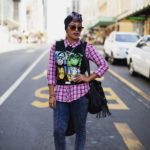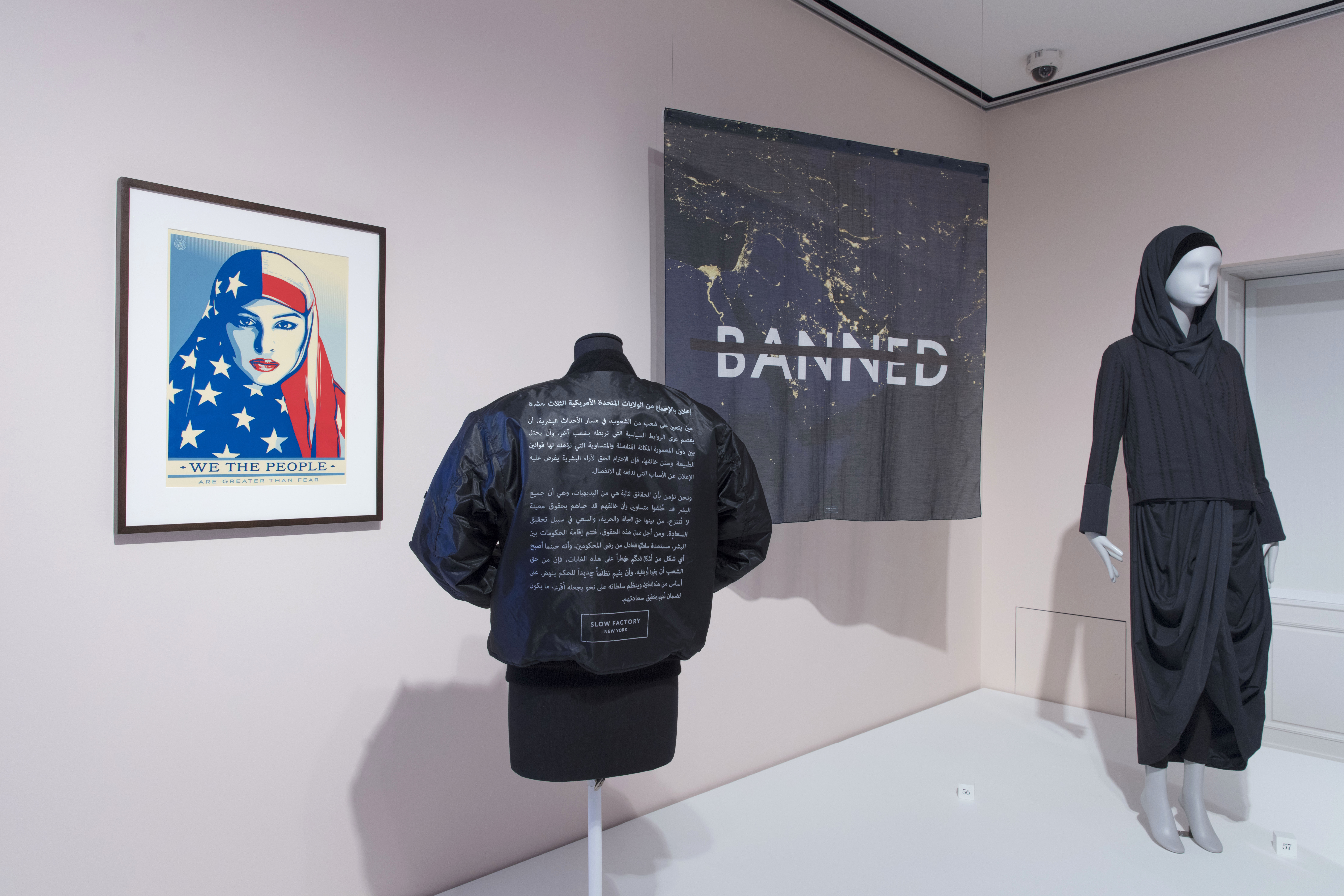Susan Brown, Associate Curator and Acting Head of Textiles, leads a virtual walk through of Contemporary Muslim Fashions.
INTRODUCTION
Contemporary Muslim Fashions explores how Muslim women are reshaping the fashion industry to be more inclusive. As designers and entrepreneurs, they have shown that clothing can be on-trend and still meet the needs of diverse wearers. As journalists, bloggers, and influencers, they have drawn international attention to the vitality of Muslim modest style. And as consumers, they have helped to build one of the fastest-growing sectors of the global fashion industry.
The exhibition architecture and graphic design are by Brooklyn-based Isometric Studio. The team used curving platforms and translucent arches to divide the open gallery into intimate, thematic rooms that foreground the voices of Muslim women. The mannequins were styled by San Francisco-based modest stylist Saba Ali. Saba described her approach to the project in this recent interview. To get in the mood, put on Mona Haydar’s Hijabi music video, which is featured in the exhibition.
MODEST FASHION
Modest fashion refers to garments that are both highly fashionable and provide sufficient body cover to address cultural concerns for modesty. Many Muslim women and men dress modestly, in accordance with their faith, but individual and collective interpretations of modesty vary widely. These photographs by street photographer Langston Hues show self-described modest fashionistas around the world.
For many people, the hijab or headscarf is the most identifiable element of Muslim women’s dress. Yet approaches to covering the head vary widely among regions, generations, and individuals. In some places, like Iran and the Aceh province in Indonesia, women are required by law to cover their heads. For other women, covering the hair may express personal piety, the conventions of her community, or any of a variety of political positions. Throughout the exhibition, works by contemporary photographers provide a nuanced commentary on the image of the covered woman. Hengameh Golestan’s iconic 1979 images show protests against compulsory covering in Iran, while Wessam Al-Badry’s Al-Kouture series explores the tension between Western-style consumerism and traditional Muslim culture.
The recent rise in the visibility of modest fashion in mainstream media is attributed to the spending power of young, professional Muslim women and the strength of a new generation of designer-entrepreneurs working in this space. Global brands have also begun to acknowledge the size of the market for modest fashion, currently valued at $44 billion per year. At every level, from Paris couture houses to Uniqlo and Macy’s, retailers have begun offering modest options to their customers. Here, dresses from online retailers Kuyabe Gider and Mary Katranzou for The Modist offer affordable versions of modest styles.
REGIONAL INTERSECTIONS
With approximately one billion Muslim women worldwide, Islam is a multicultural faith. Furthermore, many of the designers featured in the exhibition — over half of whom are Muslim women under 40 — have truly global lifestyles. By connecting international fashion trends to local styles, they are creating garments that suit the needs of both local and global audiences. In the Middle East, many young designers from the region have offered new interpretations of the abaya, the neck-to-ankle robe often worn in public. In the abaya at left by Wadha Al Hajri, hand cut-work and embroidery mimic the intricate lattice screens known as mashrabiya.
Indonesia, the largest majority-Muslim country in the world, is one of the centers of the global modest fashion industry. Many Indonesian designers embrace the rich textile heritage of the region, using luxurious materials such as batik, ikat, and songket, to create contemporary styles that retain important markers of cultural heritage. Dian Pelangi (far left and back) pays tribute to her mother’s home island of Sumatra using a machine-woven version of songket, the luxurious silk and metallic brocade traditionally woven there. Itang Yunaz’s pattern-on-pattern looks (front and far right) use both authentic hand-dyed ikat and printed versions of the hinggi mantles of Sumatra.
Migration and relocation have shaped local modest styles in the US and UK, drawing on the dress traditions of long-established communities as well as those of more recent immigrants. Philadelphia-based Naima Muhammad was introduced to so-called African wax-prints through her in-laws in Ghana; she paired Vlisco’s Angelina print with camouflage for this pattern-on-pattern looks (far left). Carmen Muhammed’s tailored suits (second from left) are contemporary takes on the tailored suits traditionally worn by members of the Nation of Islam.
GLOBAL STREET STYLE
The vibrant online community surrounding modest fashion has given rise to a dynamic street style scene. Some designers are also using fashion as a platform for addressing social and political issues.
Céine Semaan Vernon of Slow Factory in Brooklyn responded to President Trump’s original Muslim ban in 2017 with her Banned Scarf, which uses NASA open-source satellite imagery to show the seven countries included in the original ban. Proceeds from the sale of the scarf supported the ACLU’s fight to overturn the ban.
Muslim women’s increasing participation in sports has created a demand for appropriate sportswear to fit their athletic ambitions. Global brands and female entrepreneurs have begun to develop performance products geared toward both the everyday Muslim athlete and the elite competitor.
Sports hijabs and full-coverage swimwear are two important areas of innovation, and the exhibition highlights several examples of each. Californian Shereen Sabet, a scientist and long-time diver, founded Splashgear, a modest swimwear company, to encourage Muslim women to participate in water activities. She talked to us about her experiences as an entrepreneur.
If you’d like to hear more of the designers, activists, and influencers whose work is featured in the exhibition talk about modesty, inclusion, and entrepreneurship, check out this video created by the Cooper Hewitt’s Video and Audio Producer Chris Gauthier, with assistance from Micah Pegues.
Contemporary Muslim Fashions was first shown at the de Young Museum in San Francisco in fall 2018. It was curated by Jill D’Alessandro, Curator in Charge, Costume and Textile Arts and Laura L. Camerlengo, Associate Curator, Costume and Textile Arts, with Consulting Curator Reina Lewis, Professor of Cultural Studies, London College of Fashion, University of the Arts London. In spring 2019, it traveled to the AngewandteKunst in Frankfurt, Germany. At Cooper Hewitt, the exhibition was organized by Susan Brown, Associate Curator and Acting Head of Textiles.
ACKNOWLEDGEMENTS
The museum gratefully acknowledges these community leaders for their input and guidance on Cooper Hewitt’s presentation of Contemporary Muslim Fashions:
Debbie Almontaser, CEO and Founder, Bridging Cultures; Rev. Chloe Breyer, Executive Director, Interfaith Center of New York; Hanadi Doleh, Program Associate for Community Partnerships, Interfaith Center of New York; Aziza Gaouda, Manager of Operations and Community Development, Islamic Center at New York University; Adi Gil, Designer and Co-founder, threeASFOUR; Jenna Hamed, Gathering All Muslim Artists; Aliyah Khabir, Founder, AZK Communications; Afraz Khan, Events and Community Director, Muppies: Muslim Urban Professionals; Alia Khan, Chairwoman, Islamic Fashion and Design Council; Aniqa Nawabs, Executive Director, Muslim Community Network; Daniel Nelson, Director, GAMA—Gathering All Muslim Artists Collective; Edwin Reyes, Designer and Founder, Fine by Edwin Reyes.
Exhibition architecture and graphic design by Isometric Studio.
Contemporary Muslim Fashions is organized by the Fine Arts Museums of San Francisco.
The Cooper Hewitt presentation of Contemporary Muslim Fashions is made possible by support from the August Heckscher Exhibition Fund.
Additional support is provided by the Barbara and Morton Mandel Design Gallery Endowment Fund and Edward and Helen Hintz.
Funding is also provided by the Cooper Hewitt Master’s Program Fund.
















3 thoughts on “Contemporary Muslim Fashions Virtual Tour”
barbara on April 30, 2020 at 3:07 pm
I had the pleasure of seeing this show in San Francisco. It was fascinating and inspiring. I’m so sorry that New Yorkers can not see it in person but happy you have posted photos. Maybe the video can be posted? There were many Muslim women in attendance when I went and I had a chance to mingle and learn. Thank you to the curators!
gpotter on January 18, 2021 at 4:56 pm
This view of Muslim fashion was enlightening! Also pretty exciting as women’s clothes go. Some of the fabric, even seen virtually, may be brand new in the States.
Donna McDermott on April 4, 2021 at 5:36 am
What a wonderful return to elegance in the world of fashion!